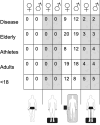High-standard predictive equations for estimating body composition using bioelectrical impedance analysis: a systematic review
- PMID: 38812005
- PMCID: PMC11137940
- DOI: 10.1186/s12967-024-05272-x
High-standard predictive equations for estimating body composition using bioelectrical impedance analysis: a systematic review
Abstract
The appropriate use of predictive equations in estimating body composition through bioelectrical impedance analysis (BIA) depends on the device used and the subject's age, geographical ancestry, healthy status, physical activity level and sex. However, the presence of many isolated predictive equations in the literature makes the correct choice challenging, since the user may not distinguish its appropriateness. Therefore, the present systematic review aimed to classify each predictive equation in accordance with the independent parameters used. Sixty-four studies published between 1988 and 2023 were identified through a systematic search of international electronic databases. We included studies providing predictive equations derived from criterion methods, such as multi-compartment models for fat, fat-free and lean soft mass, dilution techniques for total-body water and extracellular water, total-body potassium for body cell mass, and magnetic resonance imaging or computerized tomography for skeletal muscle mass. The studies were excluded if non-criterion methods were employed or if the developed predictive equations involved mixed populations without specific codes or variables in the regression model. A total of 106 predictive equations were retrieved; 86 predictive equations were based on foot-to-hand and 20 on segmental technology, with no equations used the hand-to-hand and leg-to-leg. Classifying the subject's characteristics, 19 were for underaged, 26 for adults, 19 for athletes, 26 for elderly and 16 for individuals with diseases, encompassing both sexes. Practitioners now have an updated list of predictive equations for assessing body composition using BIA. Researchers are encouraged to generate novel predictive equations for scenarios not covered by the current literature.Registration code in PROSPERO: CRD42023467894.
Keywords: BIA; Fat mass; Fat-free mass; Fitness; Resistance training; Total body water.
© 2024. The Author(s).
Conflict of interest statement
The authors declare that they have no competing interests.
Figures







References
-
- Hume PA, Ackland T. Chapter 3—physical and clinical assessment of nutritional status. In: Coulston AM, Boushey CJ, Ferruzzi MG, Delahanty E, editors. LMBT-N in the P and T of D, Academic Press; 2017. p. 71–84. https://www.sciencedirect.com/science/article/pii/B9780128029282000035.
-
- Heymsfield S, Lohman T, Wang Z, Going S. Human body composition, 2nd edn. Leeds in Champaign, IL: Human Kinetics; 2005.

